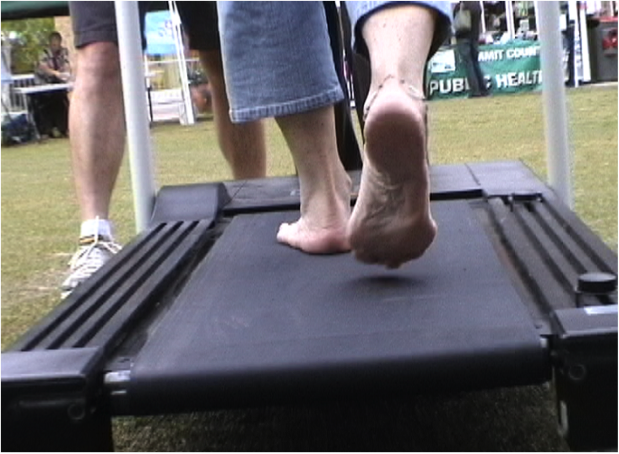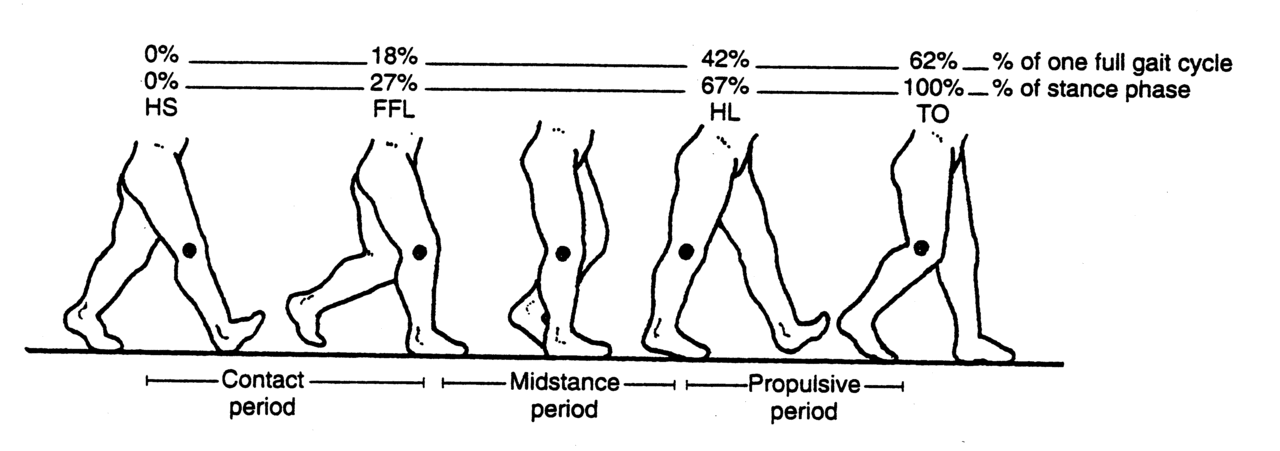Texting and Walking. Your gait will change when you are texting on your phone.
You are going to want to put away your cell phone after you read this, or at least hide your parent’s phones.
*(the video link attached here has likely been blocked by ABC News, you should see a forwarded link to their youtube feed. If not,
here it is
.
So you think you are a multi-tasker do you ? Do you know how much cerebral cortex real estate is necessary to walk or drive and text ? Just try texting while walking for 5 seconds in an unfamiliar environment and see what happens. Dual tasking is difficult especially when one task is cognitive and the other is spacial and motor. At some point something has to give, especially if you are on the edge of tapping out the executive function centers in the brain because of early disease or age related mental decline. This has never been more prevalent than in the elderly and the number of mounting studies proving that dual attention tasks lead to a dramatic increase in age related fall injuries. If you look into the literature the fall rate increases from anywhere from 11 to 50%, these are strong numbers correlating falls and dual attention tasking in the elderly. Certainly the numbers are worse in the frail and gait challenged and fewer in healthier elderly folks, but the correlation seems to be strong particularly when there are even early signs of frontal cortex demise. We have talked about this on several recent podcasts
(check out podcasts 80-85)
and this has been rooted even further from one of our neurology mentors, Dr. Ted Carrick.
Recently in the Journal of Applied Biomechanics, Parr and associated took 30 young able bodied healthy individuals with experience texting on cellular phones. The study used an 11-camera optical motion capture system on a 8m obstacle-free floor.
The study showed a reduction in gait velocity in addition to significant changes in spatial and temporal parameters, notably, step width, while the double support phase of the gait cycle increased. Furthermore, and equally disturbing, toe clearance decreased but luckily step length and cadence decreased.
Thus, it appears that the attention draining texting task generally forced the brain to slow the gait, reduce step length while improving stability via increasing step width and double support phase of gait, keep in mind that these are young healthy experienced individuals with no early cognitive challenges.
This is not the case in aging adults, or in adults with factors that have either challenged gait stability (degrees of impaired balance, vision, vestibular, proprioception etc) or challenged frontal cortex function where that functionality of the brain is already nearing its tipping point for adequate function. Sadly, these are all factors in the aging adult and they are why falls are increased and riskier for the elderly. Essentially, what the studies are showing is that dual tasking creates a distraction that can amplify any sensory-motor challenges in the system. Mind you, there are studies that show that if the dual task is remedial such as talking while walking the effects are more muted, however in those who are at the tipping point capacity of mental executive function, mere talking (cognitive linguistic engagement), can also tip the system into deciding whether to focus on the gait or the talk but not both adequately. Something will have to give in these folks, safe competent dual tasking is beyond the ability of their system.
As we have eluded to here, there are many factors and variables that can challenge the system. Visual challenges such as low light vision problems or depth perception challenges can act similarly on the system to dual tasking attempts and thus magnify fall risk. What about sensory challenges from a spinal stenosis or peripheral neuropathy such as in advancing diabetes? Balance and vestibular challenges, let alone factors such as unfamiliar environments (perhaps magnified by vision challenges) as precursors are a foregone conclusion to increase fall risk in anyone let alone the elderly.
By this point in this article it should be a given that texting while doing anything else is a dual tasking brain challenge that could lead to a fall, an embarrassing spill into the public pool or into a fountain at the mall let alone driving off a cliff or into a crowd of people. But are all of these unfortunate people showing signs of frontal cortex/executive function impairment? Perhaps not, especially if they are healthy. One has to keep in mind that texting is a high demanding cognitive attention task, even though we think nothing of it as a healthy adult. Think about it, one has to engage a separate screen other than the environment they are trying to walk through. Additionally, one has to think about what they are trying to text, engage a seperate motor program to type, then there is spelling, choosing text recipients, sending the message, watching and listening for a response, and the list goes on meanwhile the person is still trying to run the gait subprograms. We take it for granted but texting is highly engaging and adding walking can tip the system into a challenge or failure if we are in a crowd, unfamiliar environment, low light etc.
So if you have ever wondered why elderly people trip and fall in even the most benign environments, it is likely a compounded result of challenges to situation and spatial awareness and working memory with many possible factor challenges. Again, things like poor lighting, vision limitations, unfamiliar environment, vestibular limitations, numbness in the feet, talking or even if they are simply carrying the afternoon tea to the sun room these things all are dual tasking and some require higher demands from the executive function brain centers. Any factor(s) which tax the already-reducing executive function centers in the elderly subtract from the most basic elements required for upright posture and gait. If dual-tasking can impair healthy young individuals, the elderly are a forgone conclusion to have magnified risks.
There can be a plus to all of this however. If the goal were to only reduce falls and fall risks in the elderly, an astute clinician can work this to their favor and do gait challenges and retraining in the office environment while safely stacking dual task challenges to expand and restore some executive function capabilities. We are never too old to learn and lay down improved motor and cognitive patterns. So, use this information to your advantage to improve function instead of delivering it as a dark cloud to hang over your clients, whether they are elderly or neurologically challenged.
In summary, put down the darn phone, trust us, that text can wait. Rather, enjoy the sunshine, the smiling faces, the trees. If you are driving or walking, dump the phone and pay attention to traffic and your environment. Stop and wave to a friend. Teach your kids about this texting problem, they are likely already oblivious to many risks in the world, and this one likely hasn’t crossed their mind either. At the very least, help the elderly lady or man cross the street. By now you should understand all that they are consciously and subconsciously trying to calculate to negotiate the street crossing. Their declining executive function is often a mental feat all on its own, but having to actually add the physical act of walking (which is likely already showing aspects of age related biomechanical decline) might just be their tipping point leading to a fall. So offer your arm, a warm smile, and think everything of it, because someday it will be you at that street corner with sweaty palms and great fear.
Dr. Shawn Allen, one of the gait guys
References :
1.
Eur J Neurol.
2009 Jul;16(7):786-95. doi: 10.1111/j.1468-1331.2009.02612.x. Epub 2009 Mar 31.
Stops walking when talking: a predictor of falls in older adults?
Beauchet O
1,
Annweiler C
,
Dubost V
,
Allali G
,
Kressig RW
,
Bridenbaugh S
,
Berrut G
,
Assal F
,
Herrmann FR
.
2.
J Appl Biomech.
2014 Dec;30(6):685-8. doi: 10.1123/jab.2014-0017. Epub 2014 Jul 9. Cellular Phone Texting Impairs Gait in Able-bodied Young Adults.
Parr ND
1,
Hass CJ
,
Tillman MD
.
3.
Gait Posture.
2014 Aug 20. pii: S0966-6362(14)00671-7. doi: 10.1016/j.gaitpost.2014.08.007. [Epub ahead of print] Texting and walking: effects of environmental setting and task prioritization on dual task interference in healthy young adults. Plumer, Apple, Dowd, Keith.
4.
Gait Posture.
2012 Apr;35(4):688-90. doi: 10.1016/j.gaitpost.2011.12.005. Epub 2012 Jan 5. Cell Phones change the way we walk. Lamberg, Muratori
5.
Int J Speech Lang Pathol.
2010 Oct;12(5):455-9. doi: 10.3109/17549507.2010.486446. Talking while walking: Cognitive loading and injurious falls in Parkinson;s disease.
LaPointe LL
1,
Stierwalt JA
,
Maitland CG
.




























